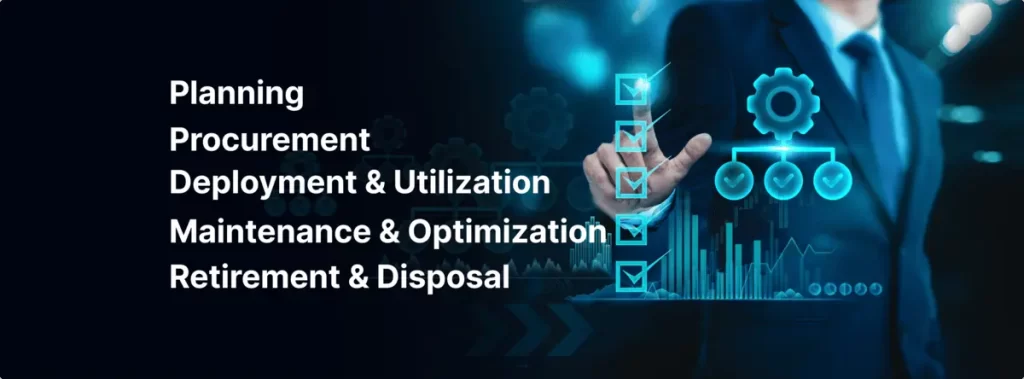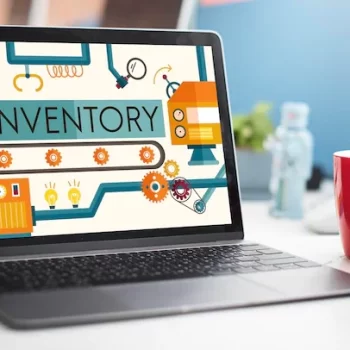The tech-driven enterprises of today rely heavily on a myriad of IT assets to keep themselves afloat. It goes without saying that maintaining the assets is paramount to ensuring your organization does not hit roadblocks such as security breaches, spiralling costs, and compliance failures.
This is where IT Asset Lifecycle Management (ITALM) comes into the picture. When implemented effectively, ITALM provides a systematic, organized way to manage every IT asset, from procurement to retirement. For a better understanding of what ITALM is, why it is essential, and the best practices to implement ITALM in your organization, read on below.
What is IT Asset Lifecycle Management (ITALM)?
The IT team in your organization must be using an IT Asset Management solution to track every piece of hardware and software in use. Lifecycle management of these assets is critical to ensure both operational and financial stability. With ITALM in place, every asset will be appropriately accounted for, utilized efficiently, and retired securely.
Take, for example, the laptops that are issued to employees. ITALM procedures play a central role in deploying laptops, monitoring their use, performing regular maintenance checks, and eventually decommissioning them securely when no longer in use. This even applies to the software services in use, such as licenses and cloud platform subscriptions.
The Importance of IT Asset Lifecycle Management
An effectively implemented ITALM strategy can bring structure and visibility to every stage of the asset’s journey. Your IT team will be able to collect actionable data and insights that can further help improve your organization’s asset management strategies. Here’s why ITALM is a crucial practice

- Have a budget? An ITALM process can help you ensure cost-effective asset procurement.
- Documentation and licensing enable you to stay ahead of audit checks and regulatory compliance requirements.
- Effective asset tracking reduces the risk of unauthorized use of hardware and software.
- Asset usage data collection can help you discover actionable insights for capacity planning.
- Procedural maintenance will help protect your assets from cyber threats.
The 5 Key Phases of the IT Asset Management Lifecycle
As with any management process, the IT Asset Management Lifecycle comprises five meticulous phases that support the ultimate goal of optimizing performance, managing costs, and ensuring compliance.

- Phase 1 – Planning
The first step is to identify which hardware and software assets are required, how many of each need to be purchased, and the budget required. Having the plan mapped out will ensure that future investments align with your organization’s goals and objectives. - Phase 2 – Procurement
A good ITALM system will let you set automated procurement workflows. With that in place, ensure transparency, prevent overspending, and maintain accurate asset records for every vendor purchase. - Phase 3 – Deployment & Utilization
This stage directly impacts employees, so having an IT Service Management system in place can help you track usage, quickly fix asset performance issues, and install necessary patches and upgrades. - Phase 4 – Maintenance & Optimization
This phase involves consciously monitoring asset performance and data. Your ITALM solution should include analytics and performance dashboards to keep everything in check. - Phase 5 – Retirement & Disposal
As with any piece of technology, there comes a time when the software or hardware in use becomes outdated or is no longer helpful to the organization. The ITALM database will have records of this and help your organization manage the secure disposal of the assets. Tasks such as erasing sensitive data and removing retired assets from active records are key practices in this phase.
Related Blog: IT Asset Management (ITAM) Best Practices
IT Asset Lifecycle Management Process Flow
An excellent ITALM system isn’t just about moving assets around and maintaining a database; it’s about planning and executing a focused strategy that ultimately benefits your organization across key areas such as costing, compliance, and efficiency.
A typical process flow looks like this:
Request → Approval → Procurement → Deployment → Monitoring → Maintenance → Decommission
Integration, Automation, and the Role of AI
Modern ITALM systems benefit greatly from advances in integrated technology, automation, and AI.
You can connect asset data with service tickets, incidents, and configuration relationships when integrating your asset management system with service management and configuration management databases. AI can do what it does best: streamline workflows, minimize manual intervention, and ensure continuous compliance across all asset types.
Best Practices for Effective IT Asset Lifecycle Management
So you’ve got a decent ITALM system in place, now how do you make the most of it? There are six specific measures you can take to ensure optimal management procedures.
- Automate Data Collection and Updates – Automation eliminates manual entry errors and maintains real-time data.
- Plan for End-of-Life Early – Integrate asset retirement policies into your lifecycle strategy to prevent data leaks.
- Conduct Regular Audits and Reporting – This will help you prevent compliance violations, identify discrepancies, and validate data.
- Implement Strong Governance and Policies – Define usage guidelines to ensure accountability.
- Maintain a Centralized Asset Repository – The best way to ensure maximum visibility and data accuracy.
- Align with ITIL and ISO 19770 Standards – This ensures consistency and compliance across asset management operations.
Benefits of Structured IT Asset Lifecycle Management
Research has shown that implementing a strong ITALM strategy can cut costs by 30% in the first year. While cost-saving is a fantastic feeling, several other ways it can benefit your organization are:
- Smarter resource allocation
- Streamlined procurement and maintenance
- Lower operational and financial risks
- Better compliance
- Complete visibility into asset ownership
Common Challenges in IT Asset Lifecycle Management
As your organization grows, your asset requirements become more complex. This can raise several concerns that could pose a challenge for your ALM system.
- Incomplete or outdated asset inventories
- Manual tracking errors and a lack of automation
- Software license non-compliance
- Integration gaps between ITAM, ITSM, and CMDB systems
- Data security issues during asset disposal
Implementing a modern ALM system is simply a must. When done right, it can truly enhance productivity, compliance, and tracking. Infraon’s ALM system has helped many companies avoid mishaps and scrutiny while boosting efficiency.
Tools and Technologies Supporting ITALM
| Tool | Type | Core Focus |
| Infraon Assets | Comprehensive IT Asset Management platform | Complete asset lifecycle visibility with automated discovery, real-time tracking, and integrated ITSM workflows for enterprises |
| Motadata IT Asset Management | Unified IT operations platform (network + ITAM + AIOps) | Visibility across infrastructure, networks, and endpoints |
| InvGate Insight | Modern ITAM/ITSM hybrid platform | Asset visibility and cost control integrated with service delivery workflows |
| ServiceNow ITAM | Enterprise-grade IT Service Management (ITSM) suite | Complete lifecycle management integrated with ITSM, CMDB, and workflow automation |
| Lansweeper | Specialized IT asset discovery and inventory platform | Profound hardware/software discovery and agentless scanning |
| ManageEngine AssetExplorer | Standalone IT Asset Management solution | IT asset tracking and software license management for mid-sized orgs |
How ITALM Aligns with Business Goals
In a world where technology is a core component of most business operations, a stable Asset Lifecycle Management system must align with business goals. Here are some ways it can be beneficial.
- Reduced Total Cost of Ownership – The longer an asset can be maintained and optimized, the lower the likelihood of frequent replacements and increased expenses.
- Supports operational resilience – ITALMs can help your organization better position itself to adapt to market changes, scale operations, and leverage new technologies.
- Enables smarter investment decisions – With an ALM in place, your organization will easily understand asset lifecycles and associated costs.
- Better overall IT budgeting and planning – Important decisions, such as resource allocation, vendor contracts, and waste minimization, can be made more easily with a strong ALM system in place.

Conclusion
IT Asset Lifecycle Management is not just about tracking assets. With Infraon’s IT Asset Lifecycle Management software, organizations can leverage valuable features such as real-time tracking, automated discovery, integrated ticketing, and vendor management, all of which enhance ROI and asset value.
FAQs
What are the main phases of the IT asset management lifecycle?
Planning, Procurement, Deployment, Maintenance, and Retirement. Each phase focuses on efficient asset control and optimization.
How does ITALM differ from general IT asset management?
ITAM is for inventory and usage tracking, while ITALM focuses on asset longevity and value.
What are IT asset lifecycle management best practices?
Centralized data tracking, automation, alignment with compliance, and proactive maintenance.
How can automation improve the IT asset management process flow?
Automation streamlines approval and maintenance workflows while reducing manual errors.
Why is proper asset disposal critical in ITALM?
Proper asset disposal enables responsible recycling or redeployment while preventing leaks of sensitive data.




















